|
|
|
Sort Order |
|
|
|
Items / Page
|
|
|
|
|
|
|
| Srl | Item |
| 1 |
ID:
163487
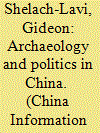

|
|
|
|
|
| Summary/Abstract |
In China, as in many other modern and contemporary states, the past is often used to inform public opinions and legitimate the political regime. This article examines two examples of archaeological exhibitions in China: at the National Museum of China (中国国家博物馆) in Beijing and the Liaoning Provincial Museum (辽宁省博物馆) in Shenyang. It discusses the development and change over time in the content of these archaeological exhibitions, the way they were organized and presented to the public, and the explanations that accompanied the prehistoric artefacts. I argue that the way the past, and in particular the distant, prehistoric and proto-historic past, is presented in Chinese museums reveals a process of entrenchment of the standardized narrative of Chinese history, with a powerful sense of connection and continuity between the past, no matter how distant, and the present. I also argue that although the general outline of the historical trajectory of the ‘Chinese civilization’ is universally accepted, small variations in the way it is presented and the different emphases of the two exhibitions can inform us about various ways of constructing local and national identities in China during the 20th century and up to the current time.
|
|
|
|
|
|
|
|
|
|
|
|
|
|
|
|
| 2 |
ID:
101040
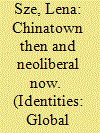

|
|
|
|
|
| Publication |
2010.
|
| Summary/Abstract |
This article explores the intersection of cultural tourism, gentrification, and urban development in the neoliberal period by examining the complex and ambivalent relationship between an "ethnic-specific" cultural institution and a rapidly gentrifying neighborhood. Through a case study of the Museum of Chinese in America's (MoCA) profile, history, and community involvement in Manhattan's Chinatown, this article suggests that small to midsize ethnic-specific museums relate to the social and spatial transformations inherent in gentrification through a mechanism called gentrification consciousness. This mechanism helps to explain how an institution whose history, mission, and politics might indicate a resistance to gentrification is confounded and constrained by the larger neoliberal landscape. Offering little in the way of substantive alternative funding and space, neoliberal urban development touts tourism and culture as key routes to economic development with gentrification as a "natural" and beneficial by-product of such development for both the surrounding neighborhood and for individual cultural institutions. An analysis of the unique relationship of smaller ethnic-specific organizations to gentrification processes complicates discussions about museums and gentrification as well as potentially identifying methods and measures of institutional success that do not rely so heavily on neoliberal logics and policy prescriptions.
|
|
|
|
|
|
|
|
|
|
|
|
|
|
|
|
| 3 |
ID:
127852
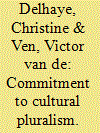

|
|
|
|
|
| Publication |
2014.
|
| Summary/Abstract |
Cultural policy has traditionally had close ties with the construction of the society as a nation state, which has been marked by its built-in tendency towards cultural homogenisation. Post-World War II, multicultural societies pose profound challenges to these traditional forms of cultural policy. Although, in the last decades, western democracies have been designing cultural diversity plans, this does not mean that governmental policies have successfully been translated in institutional practice. In the Netherlands, mainly established cultural institutions have failed to integrate diversity into their core business. Yet, there have been a few exceptions that continue to make attempts to adapt their programmes to address new populations. In this article, we use Parekh's view of a multiculturalism that reconciles unity and diversity, as a heuristic device that allows us to explore and examine the bottom-up diversity policies and practices of two Amsterdam-based cultural institutions: Paradiso and De Meervaart.
|
|
|
|
|
|
|
|
|
|
|
|
|
|
|
|
| 4 |
ID:
128478
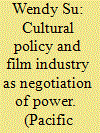

|
|
|
|
|
| Publication |
2014.
|
| Summary/Abstract |
This article explores the global-local interplay by analyzing the changing role of the Chinese state and its evolving cultural policy during its engagement with global Hollywood from 1994 to 2012. It further investigates the impact of the state policy on the formation of a domestic film industry. Drawing on both English and Chinese language sources and combining both primary and secondary empirical data, the article examines local strategies and resistance toward global Hollywood, and argues for the Chinese state's adaptive and negotiation capability that serves to reverse the power relationship in international communication. The state employs a strategy of taking advantage of Hollywood resources to build the domestic film industry in order to promote Chinese soft power. Therefore, by weaving both market forces and global capital into the state mechanism, the Chinese state effectively reinforces its authoritarian power.
|
|
|
|
|
|
|
|
|
|
|
|
|
|
|
|
| 5 |
ID:
092611
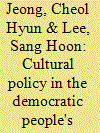

|
|
|
|
|
| Publication |
2009.
|
| Summary/Abstract |
The purpose of this paper is to introduce North Korean culture as well as its foundation, North Korean cultural policy. The paper consists of three broad sections. First, I explore the unique qualities and changes of North Korean cultural policy. Next, I look into what North Korea considers to be culture and how it is portrayed. Finally, I will analyze the similarities and differences between North and South Korean cultural policy, and the possibility of their convergence.
|
|
|
|
|
|
|
|
|
|
|
|
|
|
|
|
| 6 |
ID:
071010
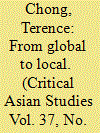

|
|
|
|
|
| Publication |
2005.
|
| Summary/Abstract |
This article explores the effects of Singapore's Global City for the Arts project on the local theater industry. It begins by describing the character of the Singapore state and its ability to meet the challenges of globalization. It then shows that while historically global in orientation, the city-state's early cultural policies were resolutely local and insular prior to the economic recession in 1985. From that year on, local arts and culture was driven by an economic rationale - eventually culminating in the birth of a globally oriented national cultural policy: the Global City for the Arts project. The author contends that the Global City for the Arts project has pressured the Singapore state into shedding some of its authoritarian practices in order to conform to international norms. However, the author also illustrates how certain theater companies with the requisite cultural capital for the Global City for the Arts project have benefited from the country's cultural policies while others that do not possess such cultural capital are marginalized. The article concludes by arguing that the Singapore state, in going global, exacerbates the economic disparity by accentuating preexisting inequalities and divisions in the local.
|
|
|
|
|
|
|
|
|
|
|
|
|
|
|
|
| 7 |
ID:
112624
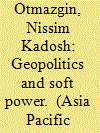

|
|
|
|
|
| Publication |
2012.
|
| Summary/Abstract |
Japan's cultural policy and cultural diplomacy in Asia has changed dramatically over the past one hundred years, from actively introducing and imposing Japanese culture during its empire-building period, to essentially avoiding the promotion of Japanese culture in Asia for most of the postwar period due to fears of being seen once again as engaged in cultural imperialism, and more recently, to supporting and encouraging the export of Japanese contemporary culture and lifestyle in order to attain "soft power." Looking at the fluctuations in Japan's cultural policy over these three periods allows us to understand how Japan has used cultural policy to further its geopolitical goals and more basically how it has viewed the role of "culture" in the context of its relations with Asian neighbors. In a broader sense, the Japanese experience shows that cultural policy, even when inward-looking, is not isolated from a country's geopolitical position and its ambitions in the world, regardless of the political system under which it operates.
|
|
|
|
|
|
|
|
|
|
|
|
|
|
|
|
| 8 |
ID:
116598
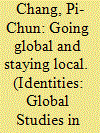

|
|
|
|
|
| Publication |
2012.
|
| Summary/Abstract |
Utilizing the 'Singapore Story', this study will explore cultural policies implemented and aimed towards cosmopolitanism, and how these policies have affected the international arts scene, which has led to a polarization within the community by excluding the elderly and disadvantaged members of the population from participating. Singapore's cultural policy has served the function of nation-building and at the same time goes with globalisation and thus calls for constructing a cosmopolitan yet patriotic citizen in terms of identity. This article considers the role of nationalism as a guide to the understanding of cultural policy discourses and argues that a top-down cosmopolitan construction of national identity in cultural policy discourses lacks representation of people's daily life.
|
|
|
|
|
|
|
|
|
|
|
|
|
|
|
|
| 9 |
ID:
127850
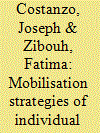

|
|
|
|
|
| Publication |
2014.
|
| Summary/Abstract |
Though sharing a common territory, the cultural spaces of Brussels are divided according to a complex structure where Francophone and Flemish Communities play a dominant role. These two language-based communities set separate cultural policies and programming for their residents in Brussels. Within this fragmented structure, local socio-cultural actors have mobilised promoting cross-Community collaboration towards a shared vision for the Brussels-Capital Region (ex. Cultural Plan for Brussels). Further, individual artists themselves have developed strategies to participate in Community-defined cultural programming and to gain recognition for their talent as local (Bruxellois) artists regardless of their ethnic, linguistic or migrant background. This article explores how socio-cultural actors and artists have mobilised to reframe 'culture' in Brussels, and to gain access to cultural venues particularly in the case of migrant and migrant-origin artists whose engagement and recognition in Brussels' cultural scenes have been little studied.
|
|
|
|
|
|
|
|
|
|
|
|
|
|
|
|
| 10 |
ID:
027793
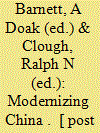

|
|
|
|
|
| Publication |
Boulder, Westview Press, 1986.
|
| Description |
xii, 136p.hbk
|
| Series |
Publication of SAIS China Forum
|
| Standard Number |
081330332X
|
|
|
|
|
|
|
|
|
|
|
|
Copies: C:1/I:0,R:0,Q:0
Circulation
| Accession# | Call# | Current Location | Status | Policy | Location |
| 026643 | 951.057/BAR 026643 | Main | On Shelf | General | |
|
|
|
|
| 11 |
ID:
168178
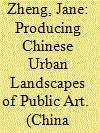

|
|
|
|
|
| Summary/Abstract |
This article uses an “urban landscapes” perspective to examine the urban sculpture scene and its production system in Shanghai. It reviews both the national urban sculpture discourse and urban sculpture planning practices since 1949, and then focuses on Shanghai specifically. It examines three major stakeholders in urban sculpture development and their interactions. The main argument is that Shanghai's urban sculpture scene has evolved due to the proliferation of aesthetic and symbolic sculptures as opposed to traditional monuments; however, urban entrepreneurialism and globalization have been shaped by the continuity of the Chinese ideological framework, which has transformed urban sculptures from explicit into veiled political didacticism under the guise of caring for the people.
|
|
|
|
|
|
|
|
|
|
|
|
|
|
|
|
| 12 |
ID:
113768
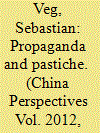

|
|
|
|
|
| Publication |
2012.
|
| Summary/Abstract |
The two Mao films of 2009 and 2011 set a new standard in the confluence of commercial and propaganda productions in terms of sheer scale. While they are not fundamentally new in repackaging propaganda as entertainment, or even in co-opting parodic elements within official discourse, this essay argues that, viewed against the background of recent policy speeches, they contribute to defining the new "mainstream socialist culture" set out as a cultural policy goal by Hu Jintao. By the same thrust, they redefine the figure of Mao and the role of the CCP in an attempt to stake out a popular consensus on the contemporary Chinese polity.
|
|
|
|
|
|
|
|
|
|
|
|
|
|
|
|
| 13 |
ID:
192996


|
|
|
|
|
| Summary/Abstract |
This paper examines the Pahlavi Dynasty Museum, which was inaugurated in 1976 during the celebrations marking the fiftieth anniversary of Pahlavi rule. Built inside the Marble Palace, the shah's former residence in the center of Tehran, the museum was intended to memorialize the achievements of the Pahlavis, presenting the official Pahlavi version of Iran's modern history. The museum was unique in many respects, not least because it was the only former Pahlavi palace that had been converted into a museum to honor the Pahlavis, but it shared the objectives of other museums constructed during this period. During the late Pahlavi era, a major aspect of the state's cultural policy was to sponsor initiatives that strengthened the official state narrative, which argued that the Pahlavis were the legitimate heirs of a 2500-year-old monarchical tradition. The article explores how the state attempted to express these narratives through the museum's design and exhibits.
|
|
|
|
|
|
|
|
|
|
|
|
|
|
|
|
| 14 |
ID:
160364
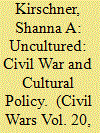

|
|
|
|
|
| Summary/Abstract |
How does cultural policy affect violence? While cultural discrimination is frequently cited as a potential grievance motivating political violence, the relationship remains under-theorised and largely untested. I weave theoretical literatures with interviews and secondary sources on the experience of Kurds in Turkey to understand the socio-economic and psychological pathways through which cultural policies impact intrastate conflict. I then analyse cross-national data on political violence, demonstrating that cultural grievances increase support for violence, raise the chance and severity of conflict and prolong violent conflicts. In short, policy matters: cultural restrictions exacerbate violence through multiple pathways.
|
|
|
|
|
|
|
|
|
|
|
|
|
|
|
|
| 15 |
ID:
108911
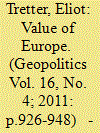

|
|
|
|
|
| Publication |
2011.
|
| Summary/Abstract |
During the 1970s and 1980s the "cultural sector" became one of the primary motors for wealth creation in the European Community. At the European and national scales, a group of actors helped transform Europe's vast array of practices and services (tourism, heritage, books, audio-visual products, etc.) into "cultural industries" and pushed the EC to develop a common cultural policy to support these industries. Documenting these changes at the European scale, I argue that the perceived impact of cultural policy for particular national economic competitiveness was also significant. Italian MEPs and members of Italy's national government were especially important, as they fought to protect the country's historical heritage and promote tourism. France pushed the strongest and I show how that country's efforts were primarily intended to protect its audio-visual and publishing industries from the EC internal market's liberalisation policies, which were vocally supported by Britain because they would have served that county's national economic interests.
|
|
|
|
|
|
|
|
|
|
|
|
|
|
|
|
| 16 |
ID:
129471
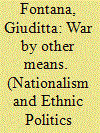

|
|
|
|
|
| Publication |
2013.
|
| Summary/Abstract |
Civil war obliterates memories of past coexistence. Yet, memories can also be erased through peacetime denial of legitimacy and funding to institutions preserving artifacts and remains testifying to a past of cultural hybridity. This article examines the interplay between cultural policy and constitutional framework in Bosnia and Herzegovina (BiH) to explain the recent closure of Sarajevo's museums. It argues that the institutions' demise reflects a new state-building project founded on the separate development of mutually exclusive cultural and ethnic communities. Amnesia about past coexistence is instrumental to the political stability of BiH's corporate consociation but may hamper long-term conflict resolution.
|
|
|
|
|
|
|
|
|
|
|
|
|
|
|
|
| 17 |
ID:
168184
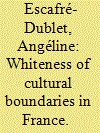

|
|
|
|
|
| Summary/Abstract |
This paper proposes to explore French cultural policy to show how the white boundary making is embedded in the ‘routine structures’ of cultural life. It takes the example of the implementation of national cultural policy as a means of seeing how the privilege of the majority operates. Against a formal insistence that the French definition of citizenship and equality does not leave room for the discussion of visible identities, it argues that immigration issues in relation to culture are relevant loci for the numerous instances of boundary drawings that it helps highlighting. Specifically, it shows how in the process of designing and implementing cultural policies, administrative officials have defined culture as artistic, universal and secular throughout the years. As a consequence of which, the privileged currently take part in the definition of artistic norms, while migration-related minorities have to justify for the social benefit of any of their artistic initiative.
|
|
|
|
|
|
|
|
|
|
|
|
|
|
|
|
| 18 |
ID:
167650
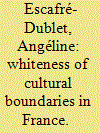

|
|
|
|
|
| Summary/Abstract |
This paper proposes to explore French cultural policy to show how the white boundary making is embedded in the ‘routine structures’ of cultural life. It takes the example of the implementation of national cultural policy as a means of seeing how the privilege of the majority operates. Against a formal insistence that the French definition of citizenship and equality does not leave room for the discussion of visible identities, it argues that immigration issues in relation to culture are relevant loci for the numerous instances of boundary drawings that it helps highlighting. Specifically, it shows how in the process of designing and implementing cultural policies, administrative officials have defined culture as artistic, universal and secular throughout the years. As a consequence of which, the privileged currently take part in the definition of artistic norms, while migration-related minorities have to justify for the social benefit of any of their artistic initiative.
|
|
|
|
|
|
|
|
|
|
|
|
|
|
|
|
|
|
|
|
|